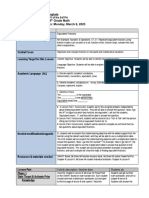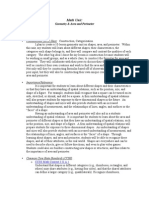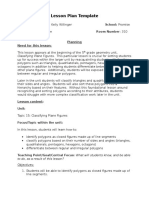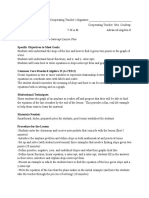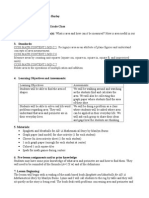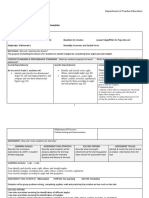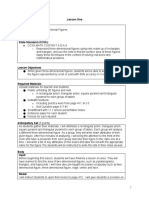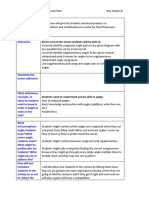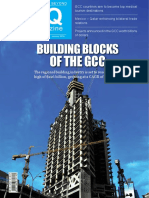Social Skills Standards That Will Also Be Addressed in Lesson
Social Skills Standards That Will Also Be Addressed in Lesson
Uploaded by
Anonymous RnIiiQkrCopyright:
Available Formats
Social Skills Standards That Will Also Be Addressed in Lesson
Social Skills Standards That Will Also Be Addressed in Lesson
Uploaded by
Anonymous RnIiiQkrOriginal Description:
Original Title
Copyright
Available Formats
Share this document
Did you find this document useful?
Is this content inappropriate?
Copyright:
Available Formats
Social Skills Standards That Will Also Be Addressed in Lesson
Social Skills Standards That Will Also Be Addressed in Lesson
Uploaded by
Anonymous RnIiiQkrCopyright:
Available Formats
Design Topic: Geometric Shapes and Area
Subject: Math
Grade: 6
Student: Marcus
STAGE 1 DESIRED RESULTS
Unit Title: Measuring Area, Surface Area, and Volume
Established Goals: (1-2 goals [standards] for your five lesson unit)
Iowa Core Standards:
th
6 Grade Mathematics Geometry:
Solve real-world and mathematical problems involving area, surface area, and volume:
Find the area of right triangles, other triangles, special quadrilaterals, and polygons by composing into rectangles or
decomposing into triangles and other shapes; apply these techniques in the context of solving real-world mathematical
problems (6.G.A.1)
Draw polygons in the coordinate plan given coordinates for the vertices; use coordinates to find the length of a side joining
points with the same first coordinate or the same second coordinate. Apply these techniques in the context of solving
real-world mathematical problems (6.G.A.3)
Social Skills Standards that will also be addressed in lesson:
Communicate and work productively with others, considering different perspectives, and cultural views to increase the
quality of work. Work appropriately and productively with others (21.6-8.ES.1)
Understandings:
Students will understand the difference between
geometric shapes: squares, circles, triangles, etc. and
what characteristics are needed to constitute each shape
Students will understand that shapes can vary in size
and area
Students will understand the difference between area
and surface area; surface area is the area of each side
added together.
Students will know:
Students will know and apply the mathematic equation of
surface area
Students will know and apply the mathematic equations
of area of a triangle, rectangle, square, and circle.
Students will know how to use a protractor and ruler
properly and accurately.
Students will know how to draw a shape on a coordinate
plane to scale.
Students will be able to reflect and shift shapes across
points and lines on a coordinate plane.
Essential Questions: (overarching)
How do different geometric shapes compare and
contrast?
What does the surface area of an object tell us about the
shape?
Why is it important to be able to accurately measure the
area and surface area of objects?
Why are some shapes better intended for some
purposes? (e.g. support beams are rectangular, globes
are spheres, etc.)
Students will be able to: (performance tasks)
Students will be able to use mathematic instruments like
a protractor and ruler to measure geometric shapes
accurately
Students will be able to identify shapes by their defining
characteristics (number of sides, angles, etc.)
Students will be able to use their measurements to find
the area of the shape
Students will be able to state the mathematic equations
for surface area, and area of rectangles, squares, circles,
and triangles.
Students will demonstrate their understanding of
geometric figures by drawing on a coordinate plane.
Students will work together in small groups and
collaborate and communicate affectively.
Source: Understanding by Design, Unit Design Planning Template (Wiggins/McTighe 2005); REVISED TEMPLATE
Design Topic: Geometric Shapes and Area
Subject: Math
Grade: 6
Student: Marcus
STAGE 2 ASSESSMENT EVIDENCE
Other Evidence: What will students do through the unit to
Performance Tasks: What will students do through the unit
demonstrate their knowledge?
in order to demonstrate their skills?
Describe four shapes: square, rectangle, circle, and
triangle by their sides and angles, record information.
Support their understanding of length and angles with
their own measurements.
Calculate the area and surface area of designated
objects in the classroom.
Communicate with their peers in whole class and small
group discussions.
Apply their knowledge individually when completing
homework assessments.
Follow teachers modeling and explicit, direct instruction
Collaborate in whole class discussions and small group
and partner work
Apply understanding when measuring the surface area of
objects in the classroom
Answer teachers guiding and follow-up questions
Complete homework and additional teacher
assessments
STAGE 3 LEARNING PLAN (Unit Plan)
Summary of Learning Activities: For each day, what do you plan to do in order to bring students to the point of being able to
answer the essential questions by the end of the unit? How will you guide students toward being able to demonstrate the key
understandings by the end of the unit?
Day 1:
1. Tell students we will be doing a unit on geometric shapes, measurement, and area. In this unit, we will be measuring
different shapes by length, angle, and size and comparing and contrasting shapes by these characteristics.
2. Lead a whole-class introductory discussion about geometric shapes. (Rationale: Helps teacher gauge students prior
knowledge). Create flow-chart on whiteboard. Students need not take notes. Possible discussion questions to ask:
What do you know about a circle, square, and triangle?
What are some additional shapes you know?
Do shapes vary in size?
Can the angles of shapes change between same-shape objects?
Why do we use some shapes for particular purposes? E.g. why are wheels round?
3. Introduce students to basic ways to describe geometric shapes. We can describe shapes by their sides and angles.
Teacher draws a triangle and rectangle on the board, asks students how many sides and angles each shape contains.
Is this true from all triangles and rectangles? So is this a defining characteristic?
4. Class activity in pairs: You have 10 minutes with a partner to identify as many geometric shapes as you can find in the
classroom. Note your findings in your notebook.
5. Class discussion about activity.
What were some of the shapes you and your partner found?
Were there shapes that others found that you didnt?
Are there some shapes in the classroom that do not fit into the shapes we have already identified in class
(square, circle, rectangle)?
6. Pass out a list of the names of shapes depending on number of sides for shapes 3-12. (3=triangle, 4=quadrilateral,
5=pentagon, 6=hexagon, 7=heptagon, 8=octagon, 9=nonagon, 10=decagon, 11=undecagon, 12=dodecagon). Ask
students to look at this list for homework tonight.
Source: Understanding by Design, Unit Design Planning Template (Wiggins/McTighe 2005); REVISED TEMPLATE
Design Topic: Geometric Shapes and Area
Subject: Math
Grade: 6
Student: Marcus
Day 2:
1. Ask students if they have questions from anything covered yesterday or from the list of shapes given at the end of
yesterdays class.
2. Tell students that today in class they will be measuring shapes in an activity with a partner.
3. Pairs of students will be given dozens of objects of varying shape and size. Students are measure the length of the sides
of each shape (in cm) and record in their notebooks. Students should round their measurements to the nearest tenth for
the purposes of this activity.
4. Have a brief discussion about note taking skills:
Make a table on the board for students to copy in their notebook.
Across the top row of the table should be the following categories: shape, description, number of sides, length of
each side, and illustration. Down the first column should be objects 1, 2, 3, 4,
This table provides an idea for helping students organize their findings. However, if students do not want to use the
table that is okay, as long as their notes include all of the above information.
5. Give students 20 minutes to complete activity with a partner. Each student should take their own notes while they are
working in pairs. Teacher walks around and discusses with pairs of students while they are working.
6. Concluding class discussion: Ask students to share some of their findings with the class.
Day 3:
1. Ask students if there are any questions from anything covered in the unit thus far.
2. Tell students that today they are going to be learning about how to graph the size of their objects from yesterday on a
coordinate plane. Ask students if they have heard of a coordinate plane before.
3. Teacher draws a coordinate plane on the board with labels of x and y-axis and units. [Modeling]
4. Teacher draws a rectangle next to the coordinate plane on board, with side lengths of 3cm and 5cm.
5. By counting units on the coordinate plane, the teacher draws the rectangle to scale on the coordinate plane board.
6. Teacher repeats above process for triangles.
7. Ask for questions.
8. Tell students to draw each of their triangular, rectangular, or square objects on coordinate planes. Challenge the students
to draw each of their shapes on one large coordinate plane with little, if any, spaces between. Each shape should be to
scale. (Rationale: This will require computation skills and will help students see the relationships between sizes of shapes
visually.)
9. Tell students they will be drawing their circular objects on coordinate planes later in the unit, since measuring a circle
involves finding its radius, which is difficult in this activity since it hard to measure the radius of circular spheres that exist
in the classroom. They can leave out these objects for now.
10. Ask students if there were any questions from todays activity.
Day 4:
1. Introduce the concept of area to students.
2. Since students already measured the length of their objects, they are also able to find their area.
3. Give students the formulas for finding the area of squares, rectangles, and triangles. (Area of a square = B x H, area of a
triangle = (B x H), area of a square = B x H). Write these formulas on the board.
4. With their partner, they are to add another column to their notebooks. They should know find the area of each triangle,
square, and rectangle they found. Students will be given 5-10 minutes.
5. Introduce and discuss the concept of surface area for measuring three-dimensional figures. Surface area = area of each
side of shape added together. Have a whole class discussion about the similarities between area and surface area on the
board. Create a Venn diagram of students thoughts on board. Students can copy Venn diagram into their notebooks.
6. Pass out surface area worksheet for homework. (*See link below)
Day 5:
1. Today, students will be furthering their knowledge about graphing shapes on a coordinate plane.
2. Have a discussion about everything students already learned about the coordinate plane and if there are any residual
questions.
3. Students will now learn how to reflect shapes over the x and y-axis of the coordinate plane, while keeping them
unchanged in terms of size, shape, scale, and angles.
4. Teacher provides model of reflecting rectangle over x-axis on whiteboard.
5. Teacher provides modeling of reflecting a triangle over y-axis on whiteboard.
6. Teacher provides modeling of reflecting a circle over the line x = 7 on whiteboard.
7. Students are given 5 problems of reflecting.
8. Repeats the steps #4-7 for shifting shapes in a coordinate plane (i.e. sliding the shape, not its reflection.)
9. Have students come together and describe what happens to shapes when you reflect them in a coordinate plane versus
shift them. When shapes are reflected, you graph the shapes inverse on the other side.
10. Pass out worksheet for homework. (*See link below)
Rationale & Resources:
I decided to conduct a math lesson because that seemed to be one of Marcus weaker subjects. While Marcus does rather
well in all of academic subjects, he was described as being a bit stronger in language arts, science and social studies. By
Source: Understanding by Design, Unit Design Planning Template (Wiggins/McTighe 2005); REVISED TEMPLATE
Design Topic: Geometric Shapes and Area
Subject: Math
Grade: 6
Student: Marcus
focusing on one of Marcus weaker subjects, I am targeting the skills and subjects where Marcus needs more work. I also
included plenty of collaborative and partner work throughout the unit. This was intentional to work on Marcus social and
communication skills. Marcus will be expected to discuss with his partners and peers respectfully. Marcus will be reminded of
respectful classroom discussion components and how do collaborate with peers effectively. Additionally, the homework
worksheets given on days three and four were selected because they have some fantastical components. The worksheets
have dinosaurs and animations that guide the students through the necessary steps. I found these worksheets online from
another teacher. I would use these worksheets as inspiration and make my own to give to Marcus if he were my student.
Idea for surface area worksheets (days 4 & 5):
http://www.sharemylesson.com/teaching-resource/surface-area-of-a-rectangular-prism-day-1-of-2-50009338/
Source: Understanding by Design, Unit Design Planning Template (Wiggins/McTighe 2005); REVISED TEMPLATE
You might also like
- Lesson Plan: Designing Bumper CarsDocument4 pagesLesson Plan: Designing Bumper CarsLauren NixonNo ratings yet
- Edtpa Lesson PlansDocument10 pagesEdtpa Lesson Plansapi-666398954No ratings yet
- Lesson Plan Windows NotesDocument3 pagesLesson Plan Windows Notesapi-33546493450% (2)
- Mathematics Lesson Plan For Kindergarten: 1. Title of The Lesson: Geometry-Shapes 2. Brief Description of The LessonDocument5 pagesMathematics Lesson Plan For Kindergarten: 1. Title of The Lesson: Geometry-Shapes 2. Brief Description of The LessonMaggie GorskaNo ratings yet
- Area and PerimeterDocument4 pagesArea and Perimeterapi-351959830100% (1)
- Siop Lesson Plan 1Document6 pagesSiop Lesson Plan 1api-522660932No ratings yet
- Linear Relationships Individual LessonsDocument11 pagesLinear Relationships Individual Lessonsapi-207664891No ratings yet
- Math Lesson Plan OgDocument7 pagesMath Lesson Plan Ogapi-400249453No ratings yet
- Gold Rush Lesson PlanDocument8 pagesGold Rush Lesson Planapi-270003746No ratings yet
- Lesson 2 Perimeter and Area in The Coordinate PlaneDocument3 pagesLesson 2 Perimeter and Area in The Coordinate Planeapi-283338157No ratings yet
- Math UnitDocument30 pagesMath Unitapi-250964578No ratings yet
- Surface Area - LessonDocument3 pagesSurface Area - Lessonapi-257911767No ratings yet
- 7th Grade Mathematics: Welcome To 7 Grade. A Successful Year of Learning Math Lies Ahead!Document5 pages7th Grade Mathematics: Welcome To 7 Grade. A Successful Year of Learning Math Lies Ahead!api-283017841No ratings yet
- Completeunitplan 1Document8 pagesCompleteunitplan 1api-355201738No ratings yet
- Grade Level: Subject: SDC, 3-6 Math, Measurements Title: Time Frame: Graph Paper Perimeters 40 MinutesDocument3 pagesGrade Level: Subject: SDC, 3-6 Math, Measurements Title: Time Frame: Graph Paper Perimeters 40 Minutesapi-253399358No ratings yet
- Unit Plan 2Document32 pagesUnit Plan 2api-272192496No ratings yet
- Mystery Lesson PlanDocument4 pagesMystery Lesson Planapi-348627392No ratings yet
- Math Unit PortfolioDocument26 pagesMath Unit Portfolioapi-286068889No ratings yet
- Lesson 2 Unit PlanDocument5 pagesLesson 2 Unit Planapi-300384449No ratings yet
- Lesson Plan Template: Teacher Candidate: Kelly Willinger School: Promise Grade Level: 5 Room Number: 310Document12 pagesLesson Plan Template: Teacher Candidate: Kelly Willinger School: Promise Grade Level: 5 Room Number: 310api-341625641No ratings yet
- Math Lesson Plan 11-24-14Document13 pagesMath Lesson Plan 11-24-14api-271087867No ratings yet
- Blank Lesson Plan Template 2021Document3 pagesBlank Lesson Plan Template 2021api-598461723No ratings yet
- Algebra 2 Lesson Plan 5.4Document3 pagesAlgebra 2 Lesson Plan 5.4houdini4No ratings yet
- Unit Lesson Plan: Standards That Bridge The Entire UnitDocument5 pagesUnit Lesson Plan: Standards That Bridge The Entire UnitKalinda HarrisNo ratings yet
- 7 - Slope-Intercept Formal Lesson PlanDocument2 pages7 - Slope-Intercept Formal Lesson Planapi-304704633No ratings yet
- Curriculum Requirements: Gomath Lesson 8.8 Choose A Tool: Standard: (Pa Common Core)Document6 pagesCurriculum Requirements: Gomath Lesson 8.8 Choose A Tool: Standard: (Pa Common Core)Emma Rissinger100% (1)
- Area and PerimeterDocument22 pagesArea and PerimeterSanchit GargNo ratings yet
- Chapter9 Mathlinks8 UnitplanDocument10 pagesChapter9 Mathlinks8 Unitplanapi-271785617No ratings yet
- Acb Area Lesson PlanDocument3 pagesAcb Area Lesson Planapi-285410422No ratings yet
- Math Measurement Lesson PlanDocument3 pagesMath Measurement Lesson PlanFranchesco TorresNo ratings yet
- Multiplication Story Problem LessonDocument4 pagesMultiplication Story Problem Lessonapi-348351025100% (1)
- Lesson Plan Linear and Exponential FunctionsDocument2 pagesLesson Plan Linear and Exponential Functionsapi-246371537No ratings yet
- Math Lesson PerimiterDocument6 pagesMath Lesson Perimiterapi-340404014No ratings yet
- Ed 302 Unit Plan Lesson 4 PDFDocument4 pagesEd 302 Unit Plan Lesson 4 PDFapi-300683985No ratings yet
- Direct Instruction Lesson Plan Rebekah OvermyerDocument4 pagesDirect Instruction Lesson Plan Rebekah Overmyerapi-487270317No ratings yet
- POD 3 Part Lesson Plan, Math Grade 5, Geometry and Spatial SenseDocument7 pagesPOD 3 Part Lesson Plan, Math Grade 5, Geometry and Spatial SenseLesley Whaley100% (1)
- Pacheco Signatureassignment Ble407Document24 pagesPacheco Signatureassignment Ble407api-293667101No ratings yet
- Math Unit Lesson PlanDocument15 pagesMath Unit Lesson Planapi-511021657No ratings yet
- Perimeter and Area LessonDocument3 pagesPerimeter and Area Lessonapi-293903807No ratings yet
- Math Final Lesson PlanDocument3 pagesMath Final Lesson Planapi-240603138No ratings yet
- Example Lesson PlansDocument15 pagesExample Lesson Plansapi-289863780No ratings yet
- Polynomial Exploration LessonDocument9 pagesPolynomial Exploration Lessonapi-281761290No ratings yet
- Dance Dance Transversal LPDocument4 pagesDance Dance Transversal LPapi-340226547No ratings yet
- LESSON PLAN CoordinateDocument11 pagesLESSON PLAN CoordinateKhairuddin MuhamadNo ratings yet
- Triangles Lesson PlanDocument5 pagesTriangles Lesson PlanalyssamanningNo ratings yet
- UbD Lesson Plan GeometryDocument5 pagesUbD Lesson Plan GeometryNiki TaylorNo ratings yet
- Activity PlanDocument13 pagesActivity Planapi-208363067No ratings yet
- Percent Problems Lesson PlanDocument5 pagesPercent Problems Lesson Planapi-249323843No ratings yet
- 16-2 PerimeterDocument4 pages16-2 Perimeterapi-304585026No ratings yet
- Lesson Plan 3Document3 pagesLesson Plan 3api-338888247No ratings yet
- Probability Lesson PlanDocument3 pagesProbability Lesson PlanLizFiedlerNo ratings yet
- Points Rays Lines - 4th GradeDocument6 pagesPoints Rays Lines - 4th Gradeapi-607366701No ratings yet
- Lesson Plan 2Document3 pagesLesson Plan 2api-338809879No ratings yet
- Finding Slope Lesson PlanDocument6 pagesFinding Slope Lesson Planapi-254064000No ratings yet
- Name: Fatema Saeed Grade Level:: Lesson Plan TemplateDocument3 pagesName: Fatema Saeed Grade Level:: Lesson Plan Templateapi-3406883780% (1)
- RoundinglessonDocument3 pagesRoundinglessonapi-273163050No ratings yet
- Lesson Plan Cartesian Plane PositiveDocument5 pagesLesson Plan Cartesian Plane Positiveapi-309707623No ratings yet
- Lesson Plan Applying GCFDocument4 pagesLesson Plan Applying GCFapi-323651040No ratings yet
- Elementary School ‘Grades 1 & 2: Math - Times Table Practice – Ages 6-8’ eBookFrom EverandElementary School ‘Grades 1 & 2: Math - Times Table Practice – Ages 6-8’ eBookNo ratings yet
- Automobile Industry: Risk ManagementDocument18 pagesAutomobile Industry: Risk ManagementYasmin HussainNo ratings yet
- FMDS0281Document67 pagesFMDS0281Sandeep YadavNo ratings yet
- Image To Caption GeneratorDocument7 pagesImage To Caption GeneratorIJRASETPublicationsNo ratings yet
- Geomantic Shield Generator, by Frater PyramidatusDocument12 pagesGeomantic Shield Generator, by Frater PyramidatusBrian Adam Newman (Frater Pyramidatus)No ratings yet
- Proposed Price Sheets V1 PDFDocument2 pagesProposed Price Sheets V1 PDFCTN2010No ratings yet
- Free RDPDocument2 pagesFree RDPPavăl Sebastian100% (2)
- Pass Leader DumpsDocument30 pagesPass Leader DumpsHyder BasetNo ratings yet
- War of Roses Research PaperDocument6 pagesWar of Roses Research Papermoykicvnd100% (1)
- ch11 Human Endocrine System Vanders Human Physiology 15e Chap011Document38 pagesch11 Human Endocrine System Vanders Human Physiology 15e Chap011sueda123eybNo ratings yet
- Indian Institute of Technology Kharagpur: Academic Calendar For The Session 2018-2019Document8 pagesIndian Institute of Technology Kharagpur: Academic Calendar For The Session 2018-2019Gin ManNo ratings yet
- Menumbuhkan Minat Baca Masyarakat Melalui Taman Bacaan Masyarakat Berbasis Teknologi InformasiDocument12 pagesMenumbuhkan Minat Baca Masyarakat Melalui Taman Bacaan Masyarakat Berbasis Teknologi InformasiDani TrashNo ratings yet
- Quick Reference Guide To PTN 910&950&960 Site MaintenanceDocument1 pageQuick Reference Guide To PTN 910&950&960 Site Maintenanceراحیل معروفNo ratings yet
- BQ MAGAZINE Jan 2016Document43 pagesBQ MAGAZINE Jan 2016mohamed ibrahimNo ratings yet
- Laserfiche 9 2 1 InstallationDocument8 pagesLaserfiche 9 2 1 Installationabdullah hamidNo ratings yet
- Cheat Codes For Pokemon Mystery Dungeon - Explorers of Time On Nintendo DS - Codejunkies US9Document2 pagesCheat Codes For Pokemon Mystery Dungeon - Explorers of Time On Nintendo DS - Codejunkies US9degraded 4resterNo ratings yet
- Notion SQL CodeDocument4 pagesNotion SQL CodephurinthammarowetNo ratings yet
- Instruction: Shade The Letter of Your Choice in The Answer Sheet Provided. No Erasures AllowedDocument6 pagesInstruction: Shade The Letter of Your Choice in The Answer Sheet Provided. No Erasures AllowedmarygraceomacNo ratings yet
- mmf2 Develop HelpDocument187 pagesmmf2 Develop HelpStelios LafazanisNo ratings yet
- RAM R1ESGo EntityReport SampleDocument4 pagesRAM R1ESGo EntityReport Samplehixane9450No ratings yet
- Distant View From Outside To Inside The Squence of Spaces Edges, Nodes & Termination of The Paths Corridors, Halls, Staircases, Lifts, EtcDocument1 pageDistant View From Outside To Inside The Squence of Spaces Edges, Nodes & Termination of The Paths Corridors, Halls, Staircases, Lifts, EtcChopra ShubhamNo ratings yet
- Performance Task 1Document3 pagesPerformance Task 1Diana CortezNo ratings yet
- ApacheHVAC User Guide - Virtual Environment - 6.1Document188 pagesApacheHVAC User Guide - Virtual Environment - 6.1leungNo ratings yet
- The Promise and The Potential of Digital Therapeutics DTX For DCDM 3hy96dDocument28 pagesThe Promise and The Potential of Digital Therapeutics DTX For DCDM 3hy96dNitin RoyNo ratings yet
- Economical Metal Anchor For Drywall and Hollow BlockDocument3 pagesEconomical Metal Anchor For Drywall and Hollow BlockPedro LanuzaNo ratings yet
- A Prototype of An Orange Picking Robot: Past History, The New Robot and Experimental ResultsDocument11 pagesA Prototype of An Orange Picking Robot: Past History, The New Robot and Experimental ResultsAnaNo ratings yet
- Static Routing Packet TracerDocument4 pagesStatic Routing Packet Tracerfalaad64No ratings yet
- Simple Past Tense - Regular VerbsDocument11 pagesSimple Past Tense - Regular VerbsFabi Usma PalacioNo ratings yet
- Ref. No. 257, S. 2019 - Submission of Participants To The Division Teacher Induction Program (TIP) 2019 PDFDocument17 pagesRef. No. 257, S. 2019 - Submission of Participants To The Division Teacher Induction Program (TIP) 2019 PDFChristine SalientesNo ratings yet
- Psychology Fi̇nal Exam Questi̇onsDocument7 pagesPsychology Fi̇nal Exam Questi̇onsdeniz hüdaverdiNo ratings yet
- Alonzo Ramos Factual ResumeDocument4 pagesAlonzo Ramos Factual ResumeThe Dallas Morning NewsNo ratings yet

